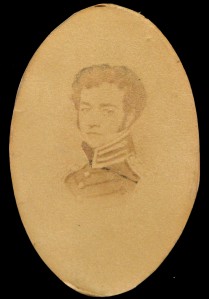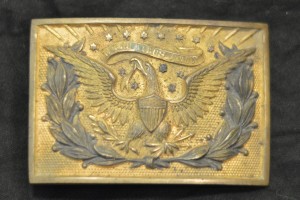James Watson Webb (1802-1884) and Helen Lispenard Stewart (1805-1848) are our fourth-great grandparents. James was the orphaned son of the famous Revolutionary War General Samuel Webb and Catherine Hogeboom, and Helen was the daughter of prominent New York banker Alexander Stewart (1775-1838) and Sarah Lispenard (1783-1831).

James – always called Watson – got his start in the Army, looking for adventure. Despite a rule limiting commissions only to West Point graduates, he convinced Secretary of War John Calhoun to make him a lieutenant based on a moral debt owed to sons of Revolutionary soldiers. He would be called “Calhoun’s scrub lieutenant,” according to biographer James Crouthamel’s biography called James Watson Webb. He was first posted to Governor’s Island, New York, in 1819, and then to Fort Dearborn, Michigan, where he had occasional run-ins with American Indians.
By 1823, though, Watson was clearly thinking of a different future than the adventures offered by the American frontier. In July 1823, he married Helen Lispenard Stewart, and her good fortune. Watson and Helen would have the following children:
- Robert Stewart Webb, 1824-1899; married Mary VanHorne Clarkson. They had one son: Robert Stewart Webb, Jr.
- Lispenard Stewart Webb, 1825-1828.
- Helen Matilda Webb, 1827-1896; married N. Denison Morgan. They had one son, Robert Webb Morgan.
- Amelia Barclay Webb, 1829-1830.
- Catherine Louisa Webb, 1830-1918; married Capt. James Benton. The had two children: Mary Benton and James Benton.
- James Watson Webb, 1832-1832.
- Watson Webb, 1833-1876; married Mary Parsons. They had three children: Francis, Helen and Elizabeth Webb.
- Alexander Stewart Webb, 1835-1911; married Anna Elizabeth Remsen(1837-1912). Alexander and Anna are our direct ancestors.
Watson left the Army for New York in 1827. That same year, his father-in-law bought a newspaper – the Morning Courier – and installed James to run it. Two years later he purchased the Enquirer and merged the two as the Morning Courier and New York Enquirer. He then established a daily horse express between Washington and New York so he could get Washington news 24 hour before any other newspaper. All of this enabled him to develop a popular “political press,” taking a highly biased approach to reporting. He physically assaulted newspaper competitors on the street on more than one occasion – presumably in defense of his honor.

In his early political efforts, Watson was a supporter of Andrew Jackson ahead of the 1832 Presidential election, but later backed Henry Clay and coined the name “Whigs” for the new party that rose in opposition to Jackson’s presidency. In 1849 Webb was appointed Minister to Austria, but since he had backed Zachary Taylor over Clay for the Whig presidential nomination in 1848, Clay led Senate opposition, and Webb was not confirmed, according to researcher Bill McKern. In 1851 he was appointed Chief Engineer on the staff of New York’s Governor with the rank of Brigadier General.
After his wife Helen’s death in 1848, Watson married 22-year-old Laura Virginia “Lena” Cram (1826-1890), the daughter of a wealthy brewer, and they had five sons:
- William Seward Webb, 1851-1926; married Eliza Osgood Vanderbilt (1860-1936) in 1881. James named William Seward Webb after New York Governor William Seward. After fighting a duel with Thomas F. Marshall, a member of congress from Kentucky, James was convicted in 1842 and served two months of his sentence but was pardoned by the Governor. Shortly after his marriage into the Vanderbilt family, William took over management of the Wagner Palace Car Company, which later merged with the Pullman Company. Webb also became President of the Adirondack and St. Lawrence Railroad, the Mohawk and Malone Railway and other ventures. He developed Shelburne Farms.
- George Creighton Webb, 1854-unknown.
- Henry Walter Webb, 1856-1919; married Amelia Howard (Griswold) Codman (1856-1910). “H. Walter” took part in the Orton expedition that traced the Amazon River nearly to its source. He joined his brother William as an executive of the Wagner Palace Car Company, and became an executive with the New York Central Railroad. He was also a Director of the National City Bank and more than twenty other companies and banks.
- Jacob Louis Webb, 1857-1928
- Francis Edgerton Webb, 1859-unknown.
Watson was a friend and supporter of Abraham Lincoln – a Republican. He and his wife Laura attended Lincoln’s inaugural. At the start of the Civil War in 1861, he declined both a commission as a Brigadier General in the Army and appointment as Minister to Turkey. He accepted the post of Minister to Brazil, a position in which he served until 1869. As Minister, Watson negotiated an agreement with his longtime acquaintance, French Emperor Napoleon III, that led to French withdrawal from Mexico and the reestablishment of Mexico’s sovereign government, also according to Bill McKern.
Watson and Helen first lived with her father at 151 Hudson Street, but moved to suit the needs of their growing family – to Broad Street in 1830, to 96 Greenwich Street in 1832, and then to 6 Carroll Place. But the place that the family would really call home was an estate called Pokahoe on the Hudson River near Tarrytown, according to the James Watson Webb biography. Watson’s second wife Laura would move into the Pokahoe estate and they raised their five sons there, as well, until they sold it 1862.

As Watson and Laura grew older, they traveled extensively, including a three-year tour of Europe. Later they would pass the time with games of whist and billiards, reading novels and attending Episcopalian services. But Watson was frequently troubled by gout, and it would contribute to his physical demise. James Watson Webb died on 7 June 1884 and was buried at Woodlawn Cemetery in the Bronx, New York, along with Laura, who died on 16 January 1890. Their grave is marked with a massive monument and plaque – perhaps appropriate for a man once called “the last of the Barons.”